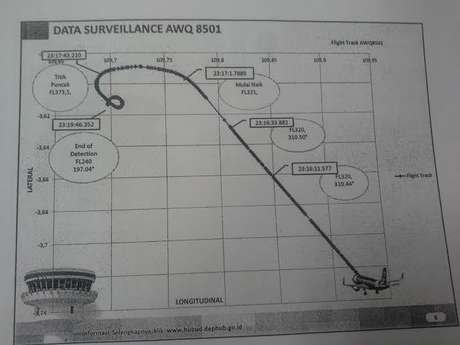Detik News reports that there was some difficulty in relocating the fuselage. Sidescan sonar was used and the fuselage was discovered "a few centimeters" from the last reported coordinates. This highlights the difficulties faced by the divers: quite apart from the strong currents, visibility is very poor due to silt and sand stirred up by the weather and currents. Furthermore: parts of the plane tend to get buried by sand and silt.
Detik News reports that the fuselage is upright but the bottom part appears to be gone, as also parts of the wing. The wreckage is 24 meters long, 8 meters wide and 3 meters high. It is at a depth of 30 meters and is 3,400 meters from the location of the now removed tail section. In the fuselage, Navy divers found 6 bodies. Diving has again been suspended due to inclement weather.
Source article (Indonesian language) - Detik.com
(Other news sources report that the bodies were found near the fuselage.)
Radar data shows last minutes of flight 8501
A journalist has obtained a document presented by the Ministry of Transportation to Commission V on Tuesday (20/01/2015) night which shows the last minutes based on radar data.

Image source: Detik News
Jakarta - Transportation Minister Ignatius Jonan said the AirAsia plane ascended rapidly for 1 minute, then descended and disappeared. What was the actual maximum altitude that the AirAsia plane achieved and how was that altitude lost?
A journalist has obtained a document presented by the Ministry of Transportation to Commission V on Tuesday (20/01/2015) night which shows the last minutes based on radar data, as follows:
23: 16: 11.577 (UTC / GMT, WIB +7)
Flight Level (FL) 320 or 32 thousand feet
23: 16: 33.882
Still at FL 320 or 32 thousand feet
Began to climb to FL 321 or 32.1 thousand feet
23:17: 43.210
At an unknown position AirAsia reached max. alt. at FL 373.5 or 37.35 thousand feet.
23: 19: 46.352
AirAsia altitude last detected at FL 240 or 24 thousand feet
From the above chart, we can see that AirAsia ascended from an altitude of 32,100 feet to an altitude of 37,350 feet: it gained 5,250 feet in just 41.4211 seconds.
The graphic was presented by MOC Jonan, which he stated originated from radar data. In a working meeting with the House of Representatives, Jonan said recent ATC data reveals that QZ8501 the fated plane suddenly experienced a high rate of climb to a height of 6,000 feet and a sudden descent then disappeared.
"It's not normal to climb so fast as it is very rare for commercial aircraft, which usually climb only as much as 1,000 to 2,000 feet per minute. This can only be done by a jet fighter," said Jonan, according to the BBC. "It can only be done by a fighter jet."
Today, Jonan confirmed this. But he insisted he did not mention 'stall' as to the conditions experienced by the AirAsia plane.
"I did not explain it as a stall, if you fall, you definitely fall. If you do not stall you certainly do not fall. So as I have already explained, the aircraft climbed several feet in one minute continuously and afterwards fell, yes the plane definitely went down," said Jonan as confirmed again in a statement at the meeting of Commission V of the House on Tuesday (20/01/2015) yesterday evening on AirAsia's sudden and rapid rise and fall.
This data submitted MOC Jonan is a new fact. Previously, elevation data obtained from AirNav QZ8501 AirAsia Indonesia, showed the last known altitude as 32 thousand feet or FL 320. At that time, the AirAsia plane requested a climb to an altitude of 34 thousand feet.
Here's the last minutes in the loss of this aircraft presented by AirNav AirAsia Indonesia on December 31, 2014:
At 06:12 pm
AirAsia requested deviation to the left of 7 miles and a climb. At that moment, the ATC immediately responded by allowing AirAsia to deviate to the left as far as 7 miles. As to height, ATC asked the pilot to maintain current height at the level of 32 thousand feet.
"Roger, AirAsia QZ8501," the pilot responded with his callsign according to ATC directives, as announced by the Director of Safety and Standard AirNav Indonesia Vishnu Darjono, Tuesday (12/30/2014).
When the ATC saw 7 planes passing around AirAsia, ATC determined a safe distance before deciding to grant permission for AirAsia to climb.
At 6:12 to 6:14 pm
"During the 2 minutes after the QZ8501 request, we (ATC) measured the distances to first secure a new permit ride height," said Vishnu.
Vishnu explained that the safe distance for a ride height that is within 10 miles of another plane. And, at the same time, there were three other aircraft that fly Air Asia QZ8501 inline with the M-635 in the path of the Emirates 406, 502 Air Asia, Air Asia 550.
"Based on the radar that we have, on average, a safe distance of approximately 10 miles from the other plane is a safe distance so as not to collide with another plane," he explained.
"Every day about 140 to 160 planes are flying on airway M635," he continued.
At 06:14 pm
ATC attempted to contact the AirAsia aircraft to allow a climb to 34 thousand feet from 32 thousand feet. However, AirAsia did not respond. ATC calleed AirAsia 8 times, with no response.
At 06:17 pm
AirAsia appeared in ADS-B signals until 6:18 pm, when AirAsia completely disappeared from the radar.
Translated from the Indonesian source at Detik News
Related articles:
Air Asia Fuselage Found - Photos
AirAsia 8501 - Both Black Boxes With NTSC
Air Asia 8501 - Some Factual Information - includes translation of
AIRASIA QZ 8501 ACCIDENT
Meteorological Analysis
By: Prof. Edvin Aidrian, Ferdika Proverbs, Jose Rizal, Kadarsah
Ocean Currents in the South Asian Archipelago
AirAsia QZ8501 No Explosion
Air Asia flight 8501 did not explode: it burst open on impact with the water.
.




Comments